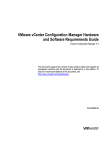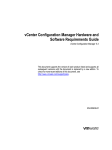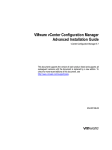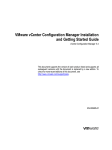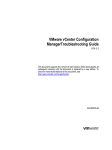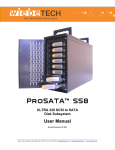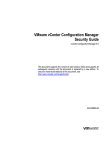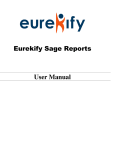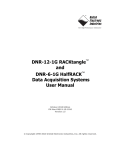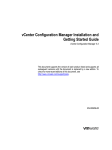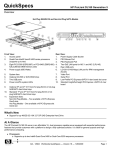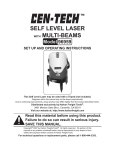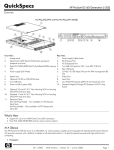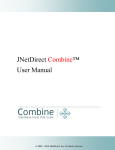Download VMware VCM 5.3 - TRANSPORT LAYER SECURITY IMPLEMENTATION User`s guide
Transcript
VMware vCenter Configuration Manager Hardware and Software Requirements Guide vCenter Configuration Manager 5.4.1 This document supports the version of each product listed and supports all subsequent versions until the document is replaced by a new edition. To check for more recent editions of this document, see http://www.vmware.com/support/pubs. EN-000741-00 vCenter Configuration Manager Hardware and Software Requirements Guide You can find the most up-to-date technical documentation on the VMware Web site at: http://www.vmware.com/support/ The VMware Web site also provides the latest product updates. If you have comments about this documentation, submit your feedback to: [email protected] © 2006-2011 VMware, Inc. All rights reserved. This product is protected by U.S. and international copyright and intellectual property laws. VMware products are covered by one or more patents listed at http://www.vmware.com/go/patents. VMware is a registered trademark or trademark of VMware, Inc. in the United States and/or other jurisdictions. All other marks and names mentioned herein may be trademarks of their respective companies. VMware, Inc. 3401 Hillview Ave. Palo Alto, CA 94304 www.vmware.com 2 VMware, Inc. Contents About This Book 5 Overview 7 Agent and Collector Host OS Platform Support VCM Agent Support on Non-English Windows Platforms Understand the VCM Installation Manager Understand VCM Installation Configurations Hardware Requirements for Collector Machines Determine the Size of Your Environment Identify Your Specific Hardware Requirements Software and Operating System Requirements for Collector Machines Sizing Impacts on Software Requirements Software Installation and Configuration Overview Upgrade Considerations Configuring a 64-bit Operating System for a VCM Installation Install and Configure a Windows Server 2008 R2 Operating System Install and Configure IIS Install .NET Framework Verify the ISAPI Extensions Install and Verify SQL XML 3.0 SP3 Install and Configure SQL Server Use SQL Server 2008 Reporting Service (SSRS) Prepare for VCM Installation Configure SQL Server for VCM SQL Server Database Settings SQL Server Processor Settings Configuring SQL Server Processor Settings SQL Server IO Configuration Use SQLIO to Determine IO Channel Throughput Hardware and Operating System Requirements for VCM Managed Machines VCM Managed Machine Requirements Windows Custom Information Supports PowerShell 2.0 Supported OS Provisioning Target Systems Software Provisioning Requirements Software Provisioning Component Software Requirements UNIX/Linux Patch Assessment and Deployment Requirements Supported OS Versions for the New UNIX Patch Assessment Content Agent Proxy Requirements for VMware ESX and ESXi Minimum Operating System Requirements Minimum Hardware Requirements VCM Support for vSphere and vCenter Server Collections vCloud Director vApp Virtual Machines Collections FIPS Requirements FIPS for Windows FIPS Used by VCM Agent Proxies VMware, Inc. 8 8 8 8 11 11 12 15 15 15 16 16 16 17 19 20 21 21 25 26 31 31 32 32 33 35 37 37 39 39 40 40 40 41 41 42 42 42 43 43 43 44 3 vCenter Configuration Manager Hardware and Software Requirements Guide Agent Sizing Information Windows Machines UNIX and Linux Machines Mac OS X Machines 44 45 46 46 Hardware and Software Requirements for the Operating System Provisioning Server Supported OS Provisioning Server Platform OS Provisioning Server System Requirements OS Provisioning Server Software Requirements Required Packages Disallowed Packages VCM Agent Patching the OS Provisioning Server OS Provisioning Server Network Requirements Provisioning Network Interface Configure the OS Provisioning Server Firewall Index 4 47 47 47 48 48 48 48 48 49 49 50 53 VMware, Inc. About This Book The VMware vCenter Configuration Manager Hardware and Software Requirements Guide describes the hardware and software requirements necessary for a successful VMware vCenter Configuration Manager (VCM) installation. This document contains the following information: n Hardware requirements for VCM Collector machines n Hardware requirements for VCM Agent machines n Software requirements and procedures for verifying or installing required components n Supplemental reference information Read this document and complete the associated procedures to prepare for a successful installation. The VCM Hardware and Software Requirements Guide applies to VCM 5.4.1, Foundation Checker 5.4, and Service Desk Connector 1.3.0. Intended Audience This information is written for experienced Windows or UNIX/Linux/Mac OS X system administrators who are familiar with managing network users and resources and with performing system maintenance. To use this information effectively, you must have a basic understanding of how to configure network resources, install software, and administer operating systems. You also need to fully understand your network’s topology and resource naming conventions. Document Feedback VMware welcomes your suggestions for improving our documentation. If you have comments, send your feedback to [email protected]. VMware VCM Documentation The vCenter Configuration Manager (VCM) documentation consists of the VCM Hardware and Software Requirements Guide, VCM Foundation Checker User's Guide, VCM Installation and Getting Started Guide, VCM online Help, and other associated documentation. VMware, Inc. 5 vCenter Configuration Manager Hardware and Software Requirements Guide Technical Support and Education Resources The following technical support resources are available to you. To access the current version of this book and other books, go to http://www.vmware.com/support/pubs. Online and Telephone Support To use online support to submit technical support requests, view your product and contract information, and register your products, go to http://www.vmware.com/support. Customers with appropriate support contracts should use telephone support for priority 1 issues. Go to http://www.vmware.com/support/phone_support.html. 6 Support Offerings To find out how VMware support offerings can help meet your business needs, go to http://www.vmware.com/support/services. VMware Professional Services VMware Education Services courses offer extensive hands-on labs, case study examples, and course materials designed to be used as on-the-job reference tools. Courses are available onsite, in the classroom, and live online. For onsite pilot programs and implementation best practices, VMware Consulting Services provides offerings to help you assess, plan, build, and manage your virtual environment. To access information about education classes, certification programs, and consulting services, go to http://www.vmware.com/services. VMware, Inc. Overview 1 Use this manual to determine your specific hardware and software requirements for VMware vCenter Configuration Manager (VCM) and to install and configure the prerequisites necessary for a successful installation. To determine your hardware and software requirements, you must begin by answering several questions. Worksheets are available later in this document to help you determine the answers to these questions. n How many Windows servers and workstations and UNIX or Linux machines do you plan to license? n How often do you intend to collect data? n How much data do you intend to collect? n How long do you plan to retain the data that you collect? n What additional VCM components do you intend to use? See the Download VMware vCenter Configuration Manager Web site for more information about VCM components. n Do you fully understand your VCM security requirements? See the VCM Security Environment Requirements Technical white paper on the Download VMware vCenter Configuration Manager Web site. To successfully install VCM, you must complete the preparatory tasks in order. 1. Understand how VCM and its related components are installed. 2. Determine your VCM Collector hardware requirements based on the number of machines in your environment and the VCM components that you plan to license. See "Hardware Requirements for Collector Machines" on page 11. 3. Determine your VCM Agent hardware requirements based on the VCM components that you plan to license. A list of supported operating systems is included. See "Hardware and Operating System Requirements for VCM Managed Machines" on page 37. 4. Prepare the Windows server to install VCM by installing and configuring the necessary software prerequisites. See "Software and Operating System Requirements for Collector Machines" on page 15. 5. Configure SQL Server to fine-tune the settings. See "Configure SQL Server for VCM" on page 31. Complete each of the activities and procedures in the order they appear. After you complete these tasks, you can run Foundation Checker to ensure that your system is ready to install VCM. Foundation Checker is a VCM application that scans the Collector machine for the necessary prerequisites. If you have questions about the configuration for Windows servers or workstations, or UNIX or Linux machines, or about any requirements not answered in this document, contact your VMware account representative or VMware Technical Support. VMware, Inc. 7 vCenter Configuration Manager Hardware and Software Requirements Guide Agent and Collector Host OS Platform Support All Agent and Collector host OS platform support is specific to versions and editions indicated in the supported platforms table. See "Hardware and Operating System Requirements for VCM Managed Machines" on page 37. All installations that have been tested use the vendor’s default configuration, except as noted. A variety of vendor-supplied, third-party, and custom lock downs, endpoint security products, policies, and restricted system configurations can reduce or block the performance or functionality of VCM components. Troubleshooting and support of VCM components in such locked-down or reconfigured environments is not included under the standard product maintenance agreement. Support in such environments is available through an additional Professional Services engagement. VCM Agent Support on Non-English Windows Platforms If you install the VCM Agent on non-English (non-ENU) Windows machines, and collect data from these machines, be aware of the following dependencies and limitations. n You might need additional language packs on machines where VCM administrators run Web consoles to display non-western data that VCM collects from these machines. n To patch Windows machines that require non-English versions of Microsoft patches, Spanish, French, and Danish are currently supported. n Compliance rules that refer to Services must use the internal names rather than the display names, because the display names might be localized. Understand the VCM Installation Manager VCM Installation Manager is a tool that steps you through the process to install all VCM components and tools. The Installation Manager installs all VCM components on your machine, even if you did not purchase licenses for all of the components. The installation process activates only the VCM components that are included in your VCM license file. This installation method allows you the flexibility to purchase more licenses and activate additional VCM components as needed. When you prepare your system for a VCM installation, determine your requirements based on the components you plan to license in your configuration. Use the hardware requirement worksheet and associated tables to assess your requirements based on your individual licensing plan. See "Hardware Requirements for Collector Machines" on page 11. Consider whether your installation configuration will include a single server or multiple servers. Understand VCM Installation Configurations VCM supports a single server installation configuration, where the Collector and the VCM SQL Server databases are installed on a single machine. See Figure 1–1. Typical VCM Enterprise-wide, Single-server Installation. In addition to the Collector, the supported configuration includes an Operating System Provisioning Server. The OS Provisioning Server manages the OS provisioning actions as commanded by VCM. See Figure 1–2. VCM Collector with OS Provisioning Server. For complete hardware and software requirements for the OS Provisioning Server, see "Hardware and Software Requirements for the Operating System Provisioning Server" on page 47. 8 VMware, Inc. Overview Figure 1–1. Typical VCM Enterprise-wide, Single-server Installation VMware, Inc. 9 vCenter Configuration Manager Hardware and Software Requirements Guide Figure 1–2. VCM Collector with OS Provisioning Server 10 VMware, Inc. Hardware Requirements for Collector Machines 2 VCM hardware requirements depend on the number of physical and virtual machines in your enterprise that you plan to license for use with VCM. Use this information to determine how many machines you plan to manage and the VCM components you plan to license. After you have this information, you can determine the individual hardware requirements that you must satisfy to ensure a successful VCM installation. Disk space requirements vary based on the following factors. n Number of machines from which you collect data n Type of data collected and filters used n Frequency of collections n Data retention Determine the Size of Your Environment VCM hardware requirements are recommended based on whether your environment contains 1–1000, 1000–2000, 2000–5000, or more managed machines. To determine the number of managed machines on which to base your collector size, consider the number of Windows servers and workstations, UNIX or Linux machines, and virtual machines that you are licensing. Identify any other VCM components that you are licensing. To determine your total number of managed machines, enter data for your enterprise in the sizing worksheet. In VCM, the term “managed machines” indicates the servers and workstations that VCM manages, and from which VCM collects data. If you are licensing VCM for Microsoft Active Directory (AD), this definition includes AD objects that you plan to have in your environment in the next 12 to 24 months. Use the formulas in the worksheets to determine how your AD objects will increase your managed machine count and affect your final sizing requirements. Taking these considerations into account now ensures that you will have adequate disk space to accommodate VCM now and in the future. After you complete the worksheet and determined the number of managed machines, you must size your Collector machine. See "Identify Your Specific Hardware Requirements" on page 12. VMware, Inc. 11 vCenter Configuration Manager Hardware and Software Requirements Guide In this example, an enterprise contains machines and objects that represent 1177 managed machines, which places it in the 1000–2000 managed machines category. Table 2–1. Sizing Worksheet Anticipated Number of Managed Machines in the Next 12-24 Months Product Description VCM Windows Servers ESX Servers Virtual Machines (VM) Windows Workstations VCM for AD Divide total number of AD objects by 100 to determine the approximate "machine count" for your AD environment. Total Managed Machines: _______ Table 2–2. Example of Sizing Worksheet with Sample Data Anticipated Number of Managed Machines in the Next 12-24 Months Product Description VCM VCM for AD Windows Servers 92 vSphere/ESX/ESXi Servers 5 Virtual Machines (VM) 50 Windows Workstations 920 Divide total number of AD objects by 100 to determine the approximate "machine count" for your AD environment. 10,000 AD Objects/100 = 100 managed machines to accommodate VCM for AD Total Managed Machines: 1177 Identify Your Specific Hardware Requirements Use the Minimum Hardware Requirements and Minimum Disk Configuration Requirements tables to determine your hardware and disk configuration requirements. Use the total number of managed machines from the Sizing Worksheet to locate your environment size (1–1000, 1000–2000, 2000–5000, or more). If you have more than 2000 machines in your environment, contact VMware Technical Support to help you determine your hardware requirements. The requirements listed in this table are based on the following assumptions. n Daily VCM collections using the default filter set with additional Microsoft AD security descriptors collected using VCM for AD n 15 days retention of data n Simple recovery mode only n Daily VCM Patching collections n No applications other than VCM running on your server If you intend to run other applications, contact VMware Technical Support to prevent conflicts. 12 VMware, Inc. Hardware Requirements for Collector Machines VCM for AD collections cause the TempDB database to grow significantly. If you have a fully populated Microsoft Active Directory and plan to perform frequent AD collections, increase your hardware requirements. Longer data retention, additional WMI, registry filters, and custom information collections also add to the requirements. For questions about how your specific requirements are affected, contact VMware Technical Support. Table 2–3. Minimum Hardware Requirements by Number of Managed Machines Requirements Number of VCM Managed Machines 1–1000 1000–2000 2000+ Processors Dual Xeon or single Dual Core 2GHz minimum Quad Xeon or two Dual Core 2GHz minimum Eight-way Xeon or four Dual Core 2GHz minimum RAM 4GB+ minimum 6GB+ minimum 12GB+ minimum Number of Separate Disk Channels 2 3 4 The space allocations in the following table do not include space for backups. Allocate backup space that is equal to the size of the VCM data for a single full backup, or larger if you want to keep multiple partial backups. Table 2–4. Minimum Disk Configuration Requirements by Number of Managed Machines Number of VCM Managed Machines 1–500 501–1000 RAID Channel and RAID Level Channel 0 – RAID 1 VMware, Inc. Usable Space OS 36GB Collector Data Files 36GB TempDB 36GB SQL Log Files 28GB Channel 1 – RAID 0+1 (recommended) or RAID 10 SQL Data Files 56GB Channel 0 – RAID 1 OS 36GB Collector Data Files 36GB TempDB 56GB SQL Log Files 56GB Channel 2 – RAID 0+1 (recommended) or RAID 10 SQL Data Files 113GB Channel 0 – RAID 1 OS 36GB Collector Data Files 54GB Channel 1 – RAID 1 TempDB 113GB Channel 2 – RAID 1 SQL Log Files 113GB Channel 3 – RAID 0+1 (recommended) or RAID 10 SQL Data Files 227GB Channel 1 – RAID 1 1001–2000 Partitions 13 vCenter Configuration Manager Hardware and Software Requirements Guide 14 VMware, Inc. Software and Operating System Requirements for Collector Machines 3 Your system must meet specific software requirements before you install VCM. The requirements are organized into steps, and you must perform each step in the order specified to ensure a smooth and efficient VCM installation. The final step in preparing your VCM Collector is to download and run the Foundation Checker tool. Running Foundation Checker helps you verify that you have satisfied all of the software requirements necessary to install VCM. All software requirements apply to your single server. For more information about installation configurations, see "Understand VCM Installation Configurations" on page 8. Sizing Impacts on Software Requirements Use the total number of managed machines that you identified in "Determine the Size of Your Environment" on page 11 to locate your environment size (1–1000, 1000–2000, 2000–5000, or more). If you have more than 2,000 managed machines on a single Collector, contact VMware Technical Support for your specific requirements. If you are deploying VCM in an environment with more than 5,000 managed machines, contact VMware for software component recommendations. Table 3–1. Minimum Software Requirements by Number of VCM Managed Machines Software Component Operating System SQL Version SSRS Version Number of Managed Machines 1–1000 1000–,000 2000–5000 Windows Server 2008 R2 Windows Server 2008 R2 SQL Server 2008 R2 Standard Edition (64-bit) SQL Server 2008 Reporting Services SQL Server 2008 R2 Standard Edition (64-bit) SQL Server 2008 Reporting Services Windows Server 2008 R2 Enterprise Edition SQL Server 2008 R2 Standard Edition (64-bit) SQL Server 2008 Reporting Services VCM supports Standard and Enterprise editions of SQL Server 2008 R2. Software Installation and Configuration Overview You must complete the preparatory steps to prepare your machine for a successful VCM installation. Follow the precise configuration procedures noted in each section. When you have completed these steps successfully, Foundation Checker should run without error, indicating that you have met the requirements necessary to install VCM. VCM supports a Collector that is running on a Windows Server 2008 R2 operating system. VMware, Inc. 15 vCenter Configuration Manager Hardware and Software Requirements Guide Upgrade Considerations To upgrade to the current version of VCM, you must have version 4.11.1 or later installed and running. For detailed upgrade procedures, see the VCM Installation and Getting Started Guide. Configuring a 64-bit Operating System for a VCM Installation To prepare your 64-bit system for a successful VCM installation, complete the procedures in the order they are presented. You must check each procedure against your system to ensure that all of the necessary components are properly installed and configured. Install and Configure a Windows Server 2008 R2 Operating System Install the correct operating system on your Collector and verify that the settings are configured for VCM operation. See "Sizing Impacts on Software Requirements" on page 15 to determine whether you require the Enterprise or Standard Edition. Prerequisites Verify that the person who performs these procedures uses a domain account with local administrator rights. Procedure 1. To verify that the user is an Administrator, follow these steps. a. Click Start and select All Programs > Administrative Tools > Computer Management. b. Expand System Tools, expand Local Users and Groups, and click Users. c. Right-click the user and click Properties. d. Click the Member Of tab and type Administrators in the object names area. e. Click Check Names and OK. To verify that the user is a domain account, follow these steps. a. Click Start and select All Programs > Administrative Tools > Computer Management. b. Expand System Tools, expand Local Users and Groups, and click Groups. c. Right-click Administrators and click Properties. d. Verify that the Domain User is listed in the Members area. 2. Install Microsoft Windows Server 2008 R2. What to do next After you install the operating system, confirm that the computer name settings for your Collector machine meet the required naming convention for VCM. The computer name must be a valid DNS machine name with no underscores. Verify that the name is correct before you proceed. If you attempt to change the machine name after the machine is identified as a Collector, problems might arise with VCM, SQL Server, and SQL Server Reporting Services. 16 VMware, Inc. Software and Operating System Requirements for Collector Machines Configure the Operating System Locale Settings Verify that your Windows Server Locale Setting is configured correctly for a VCM installation. 1. In Windows Explorer, select Start and click Control Panel > Clock, Language, and Region. 2. Click Region and Language. 3. In the Region and Language dialog box, click the Administrative tab and verify that the Language for non-Unicode programs area displays English (United States). Disable the Remote Desktop Session Host If the Remote Desktop Session Host role service is enabled, you must disable it. 1. On the taskbar, click the Server Manager icon to start Server Manager. Or, click Start and select All Programs > Administrative Tools > Server Manager. 2. Select Server Manager > Roles > Remote Desktop Services. 3. Select Remove Role Services. 4. Clear the Remote Desktop Session Host setting and follow the online instructions. Enable DCOM The DCOM (Distributed Component Object Model) protocol used to interact between application components across Windows machines. Windows operating systems include DCOM. To interact locally with Collector components, VCM Collectors require DCOM, which provides an option to manage Windows VCM managed machines. VCM managed machines do not require DCOM. Instead, you can use HTTP on VCM managed machines if you do not want to use DCOM, or if it is blocked by firewalls or disabled on the clients. You must ensure that DCOM is enable on the Collector to successfully install and run VCM. Although DCOM is enabled by default when Windows Server 2008 R2 is installed, DCOM can be disabled by a custom installation or a lock-down script. 1. Click Start and select All Programs > Administrative Tools > Component Services to open Component Services. 2. Click Computers, right-click the computer, and click Properties. 3. Click Default Properties. 4. Select Enable Distributed COM on this computer and click OK. Install and Configure IIS The VCM Collector must be running IIS 7.5, which is installed automatically when you install Windows Server 2008 R2. Configure IIS Settings To ensure correct settings for IIS 7.5, you must verify the correct IIS 7.5 Role Services are enabled on the Web server and then configure the IIS 7.5 settings. Verify the Correct IIS 7.5 Role Services are Enabled on the Web Server Enable the role services on the Web Server to ensure that the IIS settings are correct. VMware, Inc. 17 vCenter Configuration Manager Hardware and Software Requirements Guide Procedure 1. On the taskbar, click the Server Manager icon to start Server Manager. Or, click Start and select All Programs > Administrative Tools > Server Manager. 2. Expand Roles and click Web Server (IIS). If the Web Server (IIS) role does not appear, add the role. 3. In the Web Server (IIS) pane, scroll down to Role Services. 4. Verify that the following Role Services on the IIS Web server are set to Installed. If any of the Role Services are not enabled, click Add Role Services, mark the check boxes of the services to be installed, and click Install. Common HTTP Features Static Content Default Document Directory Browsing HTTP Errors HTTP Redirection Application Development ASP.NET .NET Extensibility ASP ISAPI Extensions ISAPI Filters Server Side Includes Health and Diagnostics HTTP Logging Logging Tools Request Monitor Tracing Security Basic Authentication Windows Authentication Digest Authentication Client Certificate Mapping Authentication IIS Client Certificate Mapping Authentication URL Authorization Request Filtering IP and Domain Restrictions Performance Static Content Compression Dynamic Content Compression Management Tools IIS Management Console IIS Management Scripts and Tools Management Service Configure the IIS 7.5 settings Configure the IIS 7.5 settings on the Web Server to ensure that the IIS settings are correct. 18 VMware, Inc. Software and Operating System Requirements for Collector Machines Procedure 1. Click Start and select All Programs > Administrative Tools > Internet Information Services (IIS) Manager. 2. Expand <server name>, expand Sites, and click Default Web Site. 3. In the Actions area, under Edit Site, click Bindings. 4. Click Add, set the Port to 80, and set the IP address to All Unassigned. 5. Save the settings and close the Site Bindings dialog box. 6. In the Actions area, under Manage Web Site, click Advanced Settings. 7. Expand Connection Limits and set Connection Time-out (seconds) to 3600. Install .NET Framework The VCM Collector requires .NET 3.5 Service Pack 1, which also installs versions 2.0 and 3.0. VCM 5.4.1 also supports .NET 4.0. Verify that the Collector has the required versions of .NET Framework installed. If a .NET version is missing, install the version from the Microsoft download Web site. If you installed and configured IIS, the following role services are already installed. n ASP Role Service n ASP.NET Role Service n IIS ServerSideIncludes Role Service Verify the .NET Installed Versions Verify that the correct .NET version is installed. .NET Framework Version 3.5 Service Pack 1 is installed as part of Windows Server 2008 R2. 1. On the taskbar, click the Server Manager icon to start Server Manager. Or, click Start and select All Programs > Administrative Tools > Server Manager. 2. Click Features. 3. View the feature summary, and confirm that .NET Framework 3.5.1 appears. If .NET Framework 3.5.1 does not appear, you must install it. Verify the ASP.NET Client System Web Version Verify the ASP.NET Client System Web version. 1. Click Start and select All Programs > Administrative Tools > Internet Information Services (IIS) Manager. 2. Expand <server name> and click Sites. 3. Expand Default Web Site, aspnet_client, and system_web. 4. Verify that the version is 2_0_50727. Verify the ASP Role Service Verify the status of the ASP Role Service. VMware, Inc. 19 vCenter Configuration Manager Hardware and Software Requirements Guide 1. Select Start > Administrative Tools > Server Manager. 2. Expand Server Manager (<server name>) and expand Roles. 3. Click Web Server (IIS). 4. Scroll down to Role Services. 5. Locate ASP and verify that the status is Installed. 6. If the status of the ASP Role Service is Not Installed, follow these steps a. Click Add Role Services. b. On the Select Role Services page, select the ASP role service. c. Complete the wizard to install the ASP role service for Web Server (IIS). Verify ASP.NET Role Service Verify the status of the ASP.NET Role Service. 1. Click Start and select Administrative Tools > Server Manager. 2. Expand Server Manager (<server name>) and expand Roles. 3. Click Web Server (IIS). 4. Scroll down to Role Services. 5. Locate ASP.NET and verify that the status is Installed. Verify the IIS Server-Side Includes Role Service The IIS ServerSideIncludes Role Service must be installed. 1. Click Start and select Administrative Tools > Server Manager. 2. Expand Server Manager (<server name>) and expand Roles. 3. Click Web Server (IIS). 4. Scroll down to Role Services. 5. Locate IIS ServerSideIncludes and verify that the status is Installed. 6. If the status of the ServerSideIncludes Role Service is Not Installed: a. Click Add Role Services. b. On the Select Role Services page, select the IIS ServerSideIncludes role service. c. Complete the wizard to install the IIS ServerSideIncludes role service for Web Server (IIS). Verify the ISAPI Extensions The ISAPI Extensions Role Service must be installed. 1. Click Start and select Administrative Tools > Server Manager. 2. Expand Server Manager (<server name>) and expand Roles. 3. Click Web Server (IIS). 4. Scroll down to Role Services. 5. Locate ISAPI Extensions and verify that the status is Installed. 20 VMware, Inc. Software and Operating System Requirements for Collector Machines Install and Verify SQL XML 3.0 SP3 You must install SQLXML 3.0 SP3. This version is required in addition to SQLXML4, which is installed with SQL Server 2008 R2. 1. Download and install SQLXML 3.0 Service Pack 3. The application is available as a download from Microsoft at http://www.microsoft.com/downloads/en/details.aspx?FamilyID=51d4a154-8e23-47d2-a033764259cfb53b. 2. To verify the version, in the Control Panel click Programs and select Programs and Features. 3. Verify that SQLXML 3.0 SP3 appears in the list of installed programs. 4. Verify the exact version number is at least 3.30.3457.0. 5. If the list displays only SQLXML 3.0 or the version number is not at least 3.30.3457.0, you must install the correct version. Install and Configure SQL Server VCM operates with a Standard or Enterprise edition of SQL Server. You must install the 64-bit SQL Server 2008 R2, English (United States) version on your designated Collector and verify that the settings are configured correctly for a VCM installation. If you plan to change the communication port used by SQL from the default port of 1433 to a nonstandard port number, make the changes during the installation of SQL Server and SQL Server Reporting Services (SSRS). Changing the port after you install SSRS disables SSRS communication with SQL Server, which causes an SSRS validation error during the VCM installation process. If you change the port after installation, you must configure additional SSRS settings to repair the configuration. For assistance, contact VMware Technical Support. Enable the IIS Role Enable the IIS Role and enable the ISAPI Filters, ISAPI Extensions, and .NET Extensibility roles. Procedure 1. Click Start and select All Programs > Administrative Tools > Server Manager. 2. Expand Roles. 3. Click Web Server (IIS). 4. In the Role Services pane, verify that the ISAPI Filters role, ISAPI Extensions role, and the .NET Extensibility role are set to Installed. 5. If these roles are not installed, click Add Role Services to install them. Turn Off the Windows Firewall Turn off the Windows firewall. VMware, Inc. 21 vCenter Configuration Manager Hardware and Software Requirements Guide Procedure 1. Click Start and select All Programs > Administrative Tools > Server Manager. 2. Expand Configuration. 3. Select Windows Firewall with Advanced Security. 4. In the Overview pane, click Windows Firewall Properties. 5. On the Domain Profile tab, set the Firewall state. Set the Internet Explorer Enhanced Security Mode Depending on the security level required for your environment, you might need to turn off Internet Explorer Enhanced Security Mode for Administrators and Users. Procedure 1. Click Start and select All Programs > Administrative Tools > Server Manager. 2. In the left pane, click Server Manager. 3. In the Server Summary pane, locate the Security Information area. 4. Click Configure IE ESC. 5. In the Internet Explorer Enhanced Security Configuration pop-up window, under Administrators, select Off. Install SQL Server To install SQL Server, you must complete the steps in the order presented. The installation details are focused on SQL Server installation options that are related to VCM, and are not intended as a complete SQL Server installation guide. For additional details about the installation, see the SQL Server documentation. When you install SQL Server, use the default settings in the Microsoft SQL Server Setup wizard, except where specified in this procedure. Do not select any settings other than the settings specified and the default settings unless you are familiar with the SQL Server installation settings. Before you install SQL Server 2008 R2, you must complete the preparatory steps. Prerequisites 22 n Enable the IIS Role and enable the ISAPI Filters, ISAPI Extensions, and .NET Extensibility roles. See "Enable the IIS Role" on page 21. n When you install .NET 3.5.1, use the Role Management Tool to install or configure the .NET Framework. n Install .NET 3.5.1. VCM 5.4.1 also supports .NET 4.0. n Turn off the Windows firewall. See "Turn Off the Windows Firewall" on page 21. n Depending on the security level required for your environment, you might need to turn off Internet Explorer Enhanced Security Mode for Administrators and Users. See "Set the Internet Explorer Enhanced Security Mode" on page 22. n Check for Windows updates and install them, and then restart the machine and allow Windows to configure the updates. VMware, Inc. Software and Operating System Requirements for Collector Machines CAUTION Before you begin the SQL Server 2008 R2 installation, verify that you have performed all of the preparatory tasks. Check for Windows updates to your machine and install them. If you do not ensure that your machine is updated with all Windows updates before you begin the installation, the SQL Server 2008 R2 installation process requires you to remove the SQL Server components that were flagged for installation when you started the installation. You must then begin the SQL Server 2008 R2 installation process again. Procedure 1. Run setup.exe to begin the SQL Server 2008 R2 installation. 2. In the SQL Server Installation Center, review the list of Planning options. You do not need to run the SQL System Configuration Checker. When you install VCM, the VCM Installation Manager will run the VCM Foundation Checker to ensure your system is ready for the VCM installation. 3. Click Installation and review the installation options. CAUTION Do not select Install Upgrade Advisor, even if you upgrade from SQL Server 2005 to SQL Server 2008 R2. The SQL installation might require you to click search for product updates, which installs updates to Windows Server 2008 R2. If updates are available, download and install them to prepare your machine for the SQL Server 2008 R2 installation. 4. (Optional) If Windows updates were required and installed, restart the machine. 5. (Optional) If Windows updates were installed, run setup.exe again to begin the SQL Server 2008 R2 installation. 6. Click Installation and confirm that all of the installation options are available. CAUTION Do not select Install Upgrade Advisor, even if you upgrade from SQL Server 2005 to SQL Server 2008 R2. 7. Select New installation or add features to an existing installation. 8. After the Setup Support Rules complete, click OK and wait for the process to complete. 9. Enter the Product Key. 10. Accept the License Terms. 11. On the Setup Support Files page, click Install. The results of the setup support rules must pass. 12. On the Setup Role page, select SQL Server Feature Installation. 13. On the Feature Selection page, select the following features and tools. n Instance Features: Database Engine Services and Reporting Services n Shared Features: Client Tools Connectivity and SQL Server Books online n Management Tools: Management Tools - Basic and Complete 14. On the Installation Rules page, wait for the operation to complete. If desired, you can review the detailed report. 15. On the Instance Configuration page, select Default instance. VMware, Inc. 23 vCenter Configuration Manager Hardware and Software Requirements Guide 16. On the Disk Space Requirements page, review the summary of disk usage to ensure the machine has enough space. 17. On the Server Configuration page, click Use the same account for all SQL Server services. 18. In the Account Name drop-down, select the NT AUTHORITY\SYSTEM account. 19. On the Database Engine Configuration page, ensure that Windows authentication is selected. Windows authentication is the default setting. Although SQL Server and Windows Authentication mode is allowed, Windows Authentication mode is recommended. 20. Click Add Current User to add Admin as the SQL Admin. 21. On the Reporting Services Configuration page, select Install the native mode default configuration. 22. On the Error Reporting page, do not take action and proceed to the next page. 23. On the Installation Configuration Rules page, correct any errors that might have occurred before you proceed. 24. When the rules pass, proceed to the next page. 25. On the Ready to Install page, review the features to be installed and click Install. 26. After the installation completes reports that SQL Server 2008 R2 installed successfully, close the wizard. Verify and Configure the SQL Server Properties Verify the SQL Server property settings and set the server-wide SQL database settings in preparation to install VCM. For information about server-wide and database-specific SQL Server database settings, see the VCM Installation and Getting Started Guide. 1. Click Start and select All Programs > Microsoft SQL Server 2008 R2 > SQL Server Management Studio. 2. Right-click the SQL instance and select Properties. 3. In the Server Properties dialog box, select and confirm each of the following settings. n n n General page (You cannot configure these options.) n Version: 10.50.1600.1 n Language: English (United States). If not correct, you might need to uninstall and install the correct version. n Server Collation: SQL_Latin1_General_CP1_CI_AS. If not correct, uninstall and reinstall SQL Server. Security page (You can configure these options.) n Windows Authentication mode: Recommended. Select this mode. n SQL Server and Windows Authentication mode: Although this setting is acceptable for VCM, Windows Authentication mode is recommended. Database Settings page (You can configure these options.) n Default index fill factor: Type or select a percentage value, which specifies the amount of free space in each index page when the page is rebuilt. Set the fill factor to 80% to keep 20% free space available in each index page. n Recovery interval (minutes): Type or select 5. 4. Click OK to save your changes. 24 VMware, Inc. Software and Operating System Requirements for Collector Machines Verify Matching SQL Server and Computer Names Verify that the SQL Server name matches the computer name. If you just installed SQL Server 2008 R2, this step is not necessary. If you obtained a machine that was renamed after both the operating system and SQL Server 2008 R2 were installed, you must verify and reset the server name. Procedure 1. Click Start and select All Programs > Microsoft SQL Server 2008 R2 > SQL Server Management Studio. 2. Click the Database Engine Query button. 3. In the SQL Query pane, type SELECT @@Servername and click Execute. 4. Verify that the resulting server name matches the machine name. If the server name does not match the machine name, you must reconfigure your machine so that the machine name matches the server name described in Reset the SQL Server Name. Reset the SQL Server Name If the SQL Server server name does not match the Collector machine name, you must reset the SQL Server name. If you reset the SQL Server name, you must reconfigure SSRS to connect to the new SQL Server instance. You cannot perform this procedure after you install VCM. Procedure 1. Click Start and select All Programs > Microsoft SQL Server 2008 R2 > SQL Server Management Studio. 2. Click the Database Engine Query button. 3. In the SQL Query pane, type this command and replace NewServerName with the desired server name: exec sp_dropserver @@SERVERNAME exec sp_addserver 'NewServerName', 'local' NOTE You cannot install VCM on a machine where the machine name or SQL Server server name includes an underscore. 4. Restart the SQL Server service. Click Start and select Programs > Microsoft SQL Server 2008 R2 > Configuration Tools > SQL Server Configuration Manager > SQL Server 2008 R2 Services. 5. Right-click SQL Server (MSSQLSERVER or your named instance) and select Restart. Use SQL Server 2008 Reporting Service (SSRS) You do not need to configure SQL Server 2008 Reporting Services because the settings are configured for you during installation. If you need to manage SQL Server 2008 Reporting Services or change any settings, open the Reporting Services Configuration Manager. Prerequisites Before you use SSRS, back up your configurations. See "Back Up Your SSRS Key" on page 26. VMware, Inc. 25 vCenter Configuration Manager Hardware and Software Requirements Guide Back Up Your SSRS Key Use the Microsoft command line utility, rskeymgmt.exe, to back up the symmetric key to an encrypted file. Use rskeymgmt.exe to copy your SSRS key set to a removable media device and store it in a secure location. The command line utility provides a way to delete encrypted content that can no longer be used if you cannot recover or apply the key. For details about how to use rskeymgmt.exe, see http://support.microsoft.com/kb/842425. Internet Explorer Protected Mode and SSRS On the VCM Collector, when User Account Control (UAC) is turned on and Internet Explorer Protected Mode is enabled, errors related to SSRS user permissions and web service errors on dashboards and node summaries can occur. If you access the VCM Web console from any machine other than the Collector, this issue does not occur. Access to the SSRS administration interfaces, http://localhost/reports, is also blocked by Protected Mode and UAC. VMware recommends that you do not use the VCM Web console from the Collector itself because either the VCM SSRS dashboards will not be usable or Internet Explorer security on the Collector must be reconfigured to allow the dashboards to operate. To enable SSRS dashboards on the Collector, either disable Internet Explorer Protected Mode for the zone of the Collector itself or run Internet Explorer as administrator. Do not use these options for general use because they can increase the exposure of the Collector to attacks through Internet Explorer. Procedure 1. In Internet Explorer, click Tools. 2. Click Internet Options and the Security tab. 3. Click Local intranet and clear the Enable Protected Mode (requires restarting Internet Explorer) check box. 4. Click Apply and OK, and close all instances of Internet Explorer. Prepare for VCM Installation Before you install VCM, you must verify that you have established or identified all the accounts necessary for a successful VCM installation. Establish Local Administration Rights Verify that the User ID of the person who performs the VCM installation or upgrade is a domain account in the Local Administrators group on the machine where the user installs or upgrades VCM. Establish SQL Server Administration Rights The user who installs VCM must have SQL Server sysadmin rights. Procedure 1. Click Start and select All Programs > Microsoft SQL Server 2008 R2 > SQL Server Management Studio. 2. Expand the server instance, Security, and Logins. 3. Right-click the login of the user who installs VCM and select Properties. 4. In the Select a page area, select Server Roles. 26 VMware, Inc. Software and Operating System Requirements for Collector Machines 5. In the Server roles area, check the sysadmin check box. 6. Click OK to save the settings and close the window. Verify Browser Compatibility Verify that you have installed a VCM compatible web browser on the Collector and any other machines that will be accessing the Web Console. VCM supports the following browsers. n Internet Explorer version 7.0 or 8.0. If you use IE 7, turn off the status bar for better results. n Mozilla Firefox version 2.0 or later with the Internet Explorer IE Tab add-on. This add-on requires Internet Explorer 6.0 to be installed on the machine. Identify Secure Communications Certificates VCM uses Transport Layer Security (TLS) to communicate securely over HTTP connections. TLS uses certificates to authenticate the Collector and Agents to each other. During the installation process, you must specify certificates for the Collector and the Enterprise. You can have Installation Manager generate the certificates for you or you can use your existing certificates. If you plan to use your own certificates, familiarize yourself with the certificate names so that you can select those certificates from your certificate store during installation. A Collector certificate must meet certain criteria to be valid. n The Collector certificate must be located in the local machine personal certificate store. n The Collector certificate must be valid for Server Authentication. If any Enhanced Key Usage extension or property is present, it must include the Server Authentication OID 1.3.6.1.5.5.7.3.1. If the Key Usage extension is present, it must include DIGITAL_SIGNATURE. n The Collector certificate must not be expired. NOTE If you provide your own certificates, see the Transport Layer Security (TLS) Implementation for VCM White Paper on the Download VMware vCenter Configuration Manager Web site. Identify Default Network Authority Account The Installation Manager requires that you specify the default network authority account during the installation process. VCM uses the default network authority account to collect data from Windows Agent machines. The default network authority account, which is often the system administrator’s account, must be set up in the local administrators group on each machine prior to installation and needs administrator rights on the Agent machines. You can change the network authority account later in VCM. Click Administration and select Settings > Network Authority. Procedure 1. Right-click Computer and select Manage to open Server Manager. 2. Expand Configuration, expand Local Users and Groups and click Groups. 3. Double-click Administrators and verify that the network authority account is listed as a member of the Administrators group. If the user or administrator’s group is not listed, add the user or group to the list. Ensure that the user has Windows administrator rights issued by the network administrator. VMware, Inc. 27 vCenter Configuration Manager Hardware and Software Requirements Guide Identify VMware Application Services Account The VMware Application Services Account must be a domain user. Because this account will have full administrative authority to the CSI_DOMAIN database, do not ever use it as a VCM login or for any other purpose. Procedure 1. Right-click Computer and select Manage to open Server Manager. 2. Expand Configuration, expand Local Users and Groups and click Groups. 3. Double-click Administrators and verify that the application services account is listed as a member of the Administrators group. If the user or administrator’s group is not listed, add the user or group to the list. Ensure that the user has Windows administrator rights issued by the network administrator. Assign ASP.NET Permissions to the VMware Application Services Account The VMware Application Services Account is a custom service account that requires appropriate permissions to access the IIS metabase and file system folders that are used by ASP.NET. Use the Aspnet_ regiis.exe utility to grant these permissions. Procedure 1. Open a command prompt window. 2. Set permissions for the Application Services Account, where <DomainName> is the domain name, and <AccountName> is your user account name. cd %windir%\Microsoft.NET\Framework\v2.0.50727\ aspnet_regiis -ga <DomainName>\<AccountName> Set Virtual Directory Permissions for Installation VCM uses virtual directories for several functions. Before starting Installation Manager, ensure that the user who installs VCM has local administration rights for the Default Web Site. Procedure 1. Click Start and select Administrative Tools > Internet Information Services (IIS) Manager. 2. Expand the server node and the Sites node. 3. Right-click Default Web Site and select Edit Permissions. 4. Click Security and verify that the user is listed with full rights or is a member of the Administrators group. Verify No Agent is Currently Installed The target Collector machine must not have an Agent installed. To determine if an Agent is installed, look for the default folder %systemroot%\CMAgent. Your location may vary. If the folder exists, use the steps below to uninstall the Agent components. If you know the Agent was not installed using the MSI installer, to uninstall the Agent enter the command %systemroot%\CMAgent\Uninstall\Packages\EcmAgentInstall\ UnEcmAgentInstall.exe /S INSTALL.LOG 28 VMware, Inc. Software and Operating System Requirements for Collector Machines If the Agent was installed using the MSI installer, or if you do not know how the Agent was installed, contact VMware Technical Support for alternative instructions. Run Foundation Checker Foundation Checker is a tool that runs system checks on the VCM Collector machine. Foundation Checker automatically checks the machine to verify that all of the prerequisites are satisfied for a successful installation of VCM. Installation Manager runs Foundation Checker automatically during the VCM installation. Running Foundation Checker as part of the Installation Manager process captures common issues that are difficult to remediate as well as issues related to specific components and the version of VCM being installed. Because Foundation Checker verifies component-specific issues against VCM, you should use Installation Manager to run Foundation Checker. You can run Foundation Checker as a separate tool on an existing VCM machine to ensure that the machine meets the requirements for an upgrade. However, when you run Foundation Checker as a standalone tool, the checks will not capture all of the component-specific issues related to VCM. If you are confident that the machine meets the requirements for a VCM installation, it is better to use Installation Manager to perform the detailed checks. The standalone version of Foundation Checker is available for download from the Download VMware vCenter Configuration Manager Web site. Procedure To run Foundation Checker before you receive the VCM installation package, you can download the program. 1. Download the Foundation Checker files from the Download VMware vCenter Configuration Manager Web site. 2. Review the Foundation Checker User’s Guide that is included in the self-extracting zip (EXE). The guide provides instructions to run the standalone Foundation Checker. 3. Run Foundation Checker on your Collector. Follow the instructions provided to resolve any problems that arise. VMware, Inc. 29 vCenter Configuration Manager Hardware and Software Requirements Guide 30 VMware, Inc. Configure SQL Server for VCM 4 SQL Server 2008 R2 is user friendly and designed so that even a novice Database Administrator (DBA) can set up and operate a high performing database system. However, because VCM places such a heavy load on the database, changes are required to the default settings to optimize SQL Server performance. By understanding the SQL Server actions, a DBA can tune SQL Server for use with VCM. For details about the SQL Server setting related to the VCM databases, see the VCM Installation and Getting Started Guide. SQL Server Database Settings Configure the database settings for VCM. Procedure 1. Click Start and select All Programs > Microsoft SQL Server 2008 R2 > SQL Server Management Studio. 2. Right-click the SQL instance that you installed and select Properties. 3. In the Select a page area, select Database Settings. 4. In the right pane, configure the following settings. n Default index fill factor: Type or select a percentage value, which specifies the amount of free space in each index page when the page is rebuilt. Set the fill factor to 80% to keep 20% free space available in each index page. Normally this setting is specified as part of the maintenance plan wizard. If you configure the default fill factor using this setting, remember to keep free space in an index when running a maintenance plan. n Recovery interval (minutes): Type or select 5. This setting configures the approximate amount of time that SQL Server takes to run the recovery process. The default setting is 0, which means that the system automatically adjusts this value. If you allow SQL Server to automatically adjust the recovery interval, it will base the values on the historical operation of the server. Because VCM constantly changes how it interacts with SQL Server (for example, activities differ between an inspection request and a compliance run), the server spends a lot of time constantly adjusting this value. By setting the recovery interval to 5 minutes, you allow SQL Server to forget about tuning this value. In large environments, the recovery interval can affect the overall performance of VCM. 5. Click OK to save the settings. VMware, Inc. 31 vCenter Configuration Manager Hardware and Software Requirements Guide SQL Server Processor Settings In multi-processor environments, you must configure the SQL Server use of the processors correctly by reserving a processor (removing it from SQL Server) for other functions such as the Collector service and IIS. NOTE IIS cannot make use of processor “affinity” in multi-processor machines, so it uses them all equally. Hyper-threading is a machine-level setting that must be controlled via BIOS settings. The main disadvantage of hyper-threading is that the two threads that run concurrently in one core share the same cache. If these threads are performing calculations, they will not interfere with each other and will run significantly faster than a single thread. If the threads are each working with a relatively large block of data, as when processing a SQL query, their activities will step on each other’s cache, which can cause the two threads to accomplish less work than could be accomplished by a single thread. Configuring SQL Server Processor Settings To set the maximum worker threads or boost the SQL Server priority, configure the SQL Server Processor settings. Procedure 1. Click Start and select All Programs > Microsoft SQL Server 2008 R2 > SQL Server Management Studio. 2. Right-click the SQL instance that you installed and select Properties. 3. In the Select a page area, select Processors. 4. Select the Automatically set I/O affinity mask for all processors check box, and then select all I/O Affinity check boxes for all processors in the Enable processors list. 5. In the right pane, configure the following settings as needed. n 32 To remove a processor from SQL Server, simply clear the check box next to the processor to reserve for the OS. It is best if you remove the processor that the network card will utilize so VMware, Inc. Configure SQL Server for VCM network communication will not affect SQL Server. Most cards use the first processor, although some Intel cards do use the last processor. n You must restart the SQL Server service for the changes to take effect. n If Hyper-threading is enabled, the list of processors will normally start at 0 through the number of physical cores and repeat to cover the Hyper-thread-created “processors.” To unlink the first core from SQL in a four-CPU Hyper-threaded system (eight processors according to the OS), clear the check boxes next to CPU 0 and CPU 4. NOTE This is the preferred logical processor enumeration sequence recommended to BIOS vendors by Intel as part of its Netburst architecture. A BIOS that utilizes this preferred sequence would show the two threads of the first Hyper-threaded CPU as logical CPU’s 0 and 1. To verify which algorithm is used, check with the BIOS vendor or compare SQL Server processor affinity options with and without Hyper-threading enabled. 6. Click OK to save the settings. SQL Server IO Configuration IT organizations do not analyze the technical drivers behind Disk IO subsystems, SQL Server installations can result in configurations that have RAID 5 arrays, which are not preferred for SQL Server because of a compromise between write performance and data redundancy. The more redundant a system is, the more work is required to write data. Because SQL Server is extremely disk-write intensive, performance suffers when SQL is configured with RAID 5. Understanding the RAID levels can help SQL DBAs configure the disk IO subsystem in the most efficient manner. n RAID 0. “Striping Without Parity”. In this configuration, each block of data is written to each disk in the array in a “round robin” fashion, which means each disk in the array holds only a portion of the total data written. Depending on the array configuration, this drastically improves read performance because data can be read in small parallel chunks. This method also provides improved write performance because data can be written in parallel. However, time is required to break the data into the “stripe” that will be written. Because no fault-tolerance exists in this model, when a drive fails in the array, the entire array fails. A minimum of 2 drives is required for RAID 0, and the resulting size of the array is calculated by adding the sizes of the drives together. n RAID 1. “Disk Mirroring” or “Disk Duplexing”, which means mirroring on a single channel, duplexing when multiple channels are used. In this configuration, each bit of data that is written to a single disk is duplicated on the second disk in the array. RAID 1 is limited to 2 physical disks, which means the array is capable of increasing the read performance. In a duplexed environment, the performance is theoretically doubled, while at the same time providing fault tolerance in case a drive fails. Write performance is not affected by RAID 1. Only 2 drives can participate in a RAID 1 array, and the size of the array is the same as a single disk. n RAID 5. “Disk Striping with Parity”. As with RAID 1, data is written to each disk in the array in a “round robin” fashion, but an additional block of data written as “parity” also exists. This parity information can be used to rebuild the array in case of a disk failure. RAID 5 is the most popular RAID configuration in data centers and represents an effective compromise between read performance and fault tolerance. Because time is required to calculate the parity stripe, write performance is not as good as RAID 0. A minimum of 3 disks is required for RAID 5. The size of the array is calculated by taking the added size of the total disks and subtracting the size of 1 disk. For example, 80GB + 80GB + 80GB is equal to the total array size of 160GB. VMware, Inc. 33 vCenter Configuration Manager Hardware and Software Requirements Guide n RAID 0+1. “Mirror of Stripes”. In this configuration, 2 RAID 0 arrays are mirrored with RAID 1, which provides the fast read and write performance of RAID 0 and the fault tolerant features of RAID 1, which addresses performance first and then fault tolerance. n RAID 10. “Stripe of Mirrors”. In this configuration, multiple RAID 1 arrays are also striped, which addresses fault tolerance first and then performance. When you examine the RAID levels for use with SQL Server, follow these guidelines. n SQL Server Log Files work best on RAID 10, and should never be used on RAID 5. If RAID 10 is not available, RAID 1 should be used. n SQL Server Data Files work best on RAID 0+1, but can be used on RAID 5 with little degradation in performance. n Multiple Disk channels are preferred. At the minimum, SQL Server Log files should be on a separate physical channel from the SQL Server Data files, and if possible, neither should be mixed with OS or Application files. For example, at a minimum SQL Server prefers 3 separate disk channels. In addition to selecting the appropriate RAID configuration, consider disk interface and disk drive performance. VCM data storage needs are usually low enough relative to commonly available drives that the smallest drives are sufficient. Fast drives that have fast interfaces are important, along with having a good number of “spindles” (drives) per RAID to distribute read, write, and seek activity across devices. Most high-end drives are available in 10,000 RPM or 15,000 RPM spin rates. The faster spinning drives usually seek faster and can achieve a higher sustained data throughput because more of the platter surface area passes under the heads in each second. Two primary interface technologies are suitable for use in high-throughput RAIDS. n Ultra 320 SCSI, or U320 supports up to 320MB/s throughput per channel. The HP SmartArray 6404 can support multiple U320 channels (four in the case of the SA6404) and on-board, battery-backed-up cache. The cache provides for increased read and write performance because it allows the controller to batch requests to the drives. n Serial Attached SCSI (SAS) uses special 2.5” drives, and has a higher data rate than the U320, up to 600MB/s for newer controllers. SAS controllers typically have more ports than the channels in U320 controllers. Ports and channels are similar because they provide parallel data paths through the controller. For example, an HP P600 provides 8 ports and each port is capable of 300MB/s. For U320, the interface capacity is often the bottleneck. With SAS, the drives themselves can be the bottleneck. SAS seems to provide better performance, flexibility, and scalability than U320 for VCM installations. In addition to being faster and usually less expensive, SAS drives, although smaller, allow for more spindles in the same rack space. Regardless of the technology used, a consideration when designing RAIDs is that it is generally best to utilize multiple channels or ports for high-throughput logical drives. For example, an 8-drive RAID 1+0 on a single U320 channel provides 320MB/s of sustained throughput, while the same drives in a RAID with four on each channel of a two-channel U320 controller (striped within the channels and mirrored between channels) provides 640MB/s sustained throughput and offers additional fault tolerance to controller channel or cable problems. If each quad of drives is in a different cabinet, this setup also provides fault tolerance for cabinet failures. An alternative to local storage for VCM is to use SAN storage. A common problem with SANs and VCM previously was that many SANs are designed for file server or mailbox use and are not well-suited to high-throughput OLTP-type activities. For a SAN to provide good performance with VCM, it must be properly configured internally, and all devices between the SAN and the Collector must be adequate for 34 VMware, Inc. Configure SQL Server for VCM the task. A 4Gb HBA is capable of slightly higher throughput than the single Ultra 320 SCSI channel. For write activities, since mirroring and striping is handled internally at the SAN, the throughput of the 4Gb HBA is more comparable to two and a half U320 channels. Getting that throughput depends also on the switches and links between the Collector and the SAN and between the drives and the controllers in the SAN. When considering SAN storage for VCM, throughput (read and write speed) and access latency should be considered. Both are important because VCM performs many relatively small reads and writes. If the latency is too high, performance will be impacted as SQL Server waits for responses to these small queries before it can perform the next task. After you have installed a Collector, analyze performance of the disk subsystem using Performance Monitor. The main counters of interest are the Physical Disk object’s Disk Bytes/sec and Average Disk Queue Length counters. You can monitor both of these counters on a per-instance basis to determine the throughput and the number of threads that are queued for each logical drive that is associated with VCM activity. The Disk Queue Length value is the best initial indicator about whether a logical drive has sufficient throughput and access speed for the tasks being required. Typically, the Disk Queue Length should not be more than twice the number of processors in the system for more than very short periods of time. When viewing this counter, a logical drive that is also used by the page file may show high queuing due to insufficient RAM in the system, but this counter can be very useful in determining whether disk subsystem resources are appropriate and whether the resources are optimally arranged, such as disks per channel, RAID type, etc. Use SQLIO to Determine IO Channel Throughput SQLIO is a tool that determines the I/O capacity of a SQL configuration. To predict how well VCM will function on a particular IO configuration and to obtain a baseline of how well the IO subsystem functions, run SQLIO before you install VCM. After you install SQLIO, configure these SQLIO settings to ensure an accurate report of IO throughput: n 64K Block Size n 4 Threads n 2GB File Size minimum n Sequential IO When you execute SQLIO, ensure that you create baseline information for each IO channel (logical disk) that will be used for VCM data as well as testing both Read and Write operations. Procedure Download SQLIO from the Microsoft download site. VMware, Inc. 35 vCenter Configuration Manager Hardware and Software Requirements Guide 36 VMware, Inc. 5 Hardware and Operating System Requirements for VCM Managed Machines VCM collects data from Windows and UNIX machines that VCM manages. The VCM Agent is supported on many different machine and operating system types. VCM Managed Machine Requirements VCM supports many machines and operating systems. VCM continually introduces support for additional platforms and operating systems. If the list does not include your specific combination of platform and operating system, contact VMware Technical Support to confirm whether your configuration is supported by a later version of VCM. Machines that are noted with a specific Agent version are supported with the Agent version listed. For machines that are noted with support up to the a certain Agent version, you could install an earlier version of the Agent on these platforms, but you cannot install a newer Agent, which means that you cannot use the latest features on those machines. Contact VMware Technical Support for previously supported Agents. The following x64 platforms are tested. n Windows: Intel64 and AMD64 n Linux: Intel64 and AMD64 n Solaris: Intel64 Itanium is not supported for Windows or UNIX/Linux, except for HP-UX for Itanium servers. Several machines are marked with an asterisk (*). These machines include a pre-VCM 5.2.1 Agent and might not report the name of the operating system correctly. You should upgrade the Agents on these machines. Table 5–1. Agent Operating System and Hardware Requirements Agent Supported Operating System Supported Hardware Platform Windows Microsoft Windows 2003 x86 and x64 Microsoft Windows 2003 R2 x86 and x64 Microsoft XP Professional (including SP3) x86 and x64 Microsoft XP Professional (SP2 and earlier up to 5.2.1 Agent only) x86 and x64 Microsoft Vista Business (including SP1) x86 and x64 * Microsoft Vista Ultimate (including SP1) x86 and x64 * Microsoft Vista Enterprise (including SP1) x86 and x64 * VMware, Inc. Platforms To Be Upgraded 37 vCenter Configuration Manager Hardware and Software Requirements Guide Agent UNIX/Linux Supported Operating System Supported Hardware Platform Platforms To Be Upgraded Microsoft Windows Server 2008 x86 and x64 * Microsoft Windows Server 2008 R2 x86 and x64 * Microsoft Windows 7 Business x86 and x64 Microsoft Windows 7 Ultimate x86 and x64 Microsoft Windows 7 Enterprise x86 and x64 AIX 5L 5.3 (up to 5.4.0 Agent only) RISC AIX 6L 6.1 RISC and PowerPC Debian 4.0 (Package LSB-Release is required) x86 and x64 * ESX 4.1 Update 1 ESXi 4.1 Update 1 ESXi 5.0 HP-UX 11i v1.0 (11.11) (up to 5.4.0 Agent only) PA-RISC (If you install the Agent on HPUX 11.11, patch PHSS_ 30966 is required.) Supported in trusted mode in the default configuration. HP-UX 11i v2.0 (11.23) (up to 5.4.0 Agent only) Itanium HP-UX 11i v2.0 (11.23) (up to 5.4.0 Agent only) PA-RISC HP-UX 11i v3.0 (11.31) Itanium HP-UX 11i v3.0 (11.31) PA-RISC Red Hat Enterprise Linux 3 (ES/AS) including Desktop with Workstation edition (up to 5.4.0 Agent only) x86 Red Hat Enterprise Linux 4 (ES/AS) including Desktop with Workstation edition x86 and x64 Red Hat Enterprise Linux 5.0, 5.1, 5.2, 5.3, 5.4, 5.5, 5.6, 6.0, Server, Desktop with Workstation, and Advanced Platform x86 and x64 Solaris 9 (up to 5.4.0 Agent only) Sparc and Sparc-V9 Solaris 10 Sparc, Sparc(Certified and verified on Solaris 10 zfs and custom V9, x86, and information data class collections on both zfs and vxfs.) x64 SUSE Linux Enterprise Server (SLES) 9 (up to 5.4.1 Agent x86 and x64 only) Mac OS X (Servers and Workstations) Oracle 9i 38 SUSE Linux Enterprise Server (SLES) 10, 10.2, 10.3, 11, 11.1 x86 and x64 Mac OS X 10.5 (up to 5.4.1 Agent only) Intel and PowerPC Mac OS X 10.6 Intel-based Apple platforms only Solaris 9 Sparc and Sparc-V9 Solaris 10 Sparc and Sparc-V9 VMware, Inc. Hardware and Operating System Requirements for VCM Managed Machines Agent Supported Operating System Supported Hardware Platform Oracle 10g Solaris 9 Sparc-V9 Solaris 10 Sparc-V9, x86, and x64 Active Directory Microsoft Windows 2000 VCM Remote Platforms To Be Upgraded x86 Microsoft Windows 2003 x86 and x64 Microsoft Windows 2003 R2 x86 and x64 Microsoft Windows 2008 x86 and x64 Supports the same platforms as the Windows Agent. Windows Custom Information Supports PowerShell 2.0 Windows Custom Information (WCI) uses PowerShell as the scripting engine and the element-normal XML format as the output that is inserted into the VCM database. WCI supports PowerShell 2.0 and works with later versions of PowerShell. n PowerShell 2.0 is the base requirement for WCI in VCM because of its ability to set the execution policy at the process level. n You can run WCI PowerShell collection scripts against Windows machines that have PowerShell 1.0 installed, although this usage is not supported or tested. If the collection scripts do not use PowerShell 2.0 commands, any of your WCI filters that use the in-line method to pass a WCI script to PowerShell will operate correctly. With PowerShell 2.0, you can set the script signing policies at the machine, user, and process levels. The process level runs a single execution of powershell.exe. In VCM, Windows Custom Information (WCI) uses script type information in the collection filter to determine how to execute PowerShell and how to pass the script to it. For more information, see the VCM Installation and Getting Started Guide. Supported OS Provisioning Target Systems You use OS provisioning to install the following operating system on machines with at least 1GB RAM. Table 5–2. Supported Operating Systems Operating System Versions ESX 4.0u1/u2, 4.1, 4.1u1 ESXi 4.1, 4.1u1, 5.0 Windows 2008 R2 - 64-bit - Std, Ent, Web, DC, StdCore, EntCore, WebCore, DCCore SP2 - i386 and 64-bit - Std, Ent, DC, StdCore, EntCore, DCCore Windows 7 Pro i386 and 64-bit Windows 2003 R2 SP2 - i386 and 64-bit - Std, Ent SUSE Linux Enterprise Server (SLES) 10.3, 32- and 64-bit 11.1, 32- and 64-bit VMware, Inc. 39 vCenter Configuration Manager Hardware and Software Requirements Guide Operating System Versions Red Hat Enterprise Linux (RHEL) (Server only) 5.0, 5.2, 5.4, 5.5, 5.6, 6.0 32- and 64-bit For more information about configuring the OS Provisioning Server for installation, see "Hardware and Software Requirements for the Operating System Provisioning Server" on page 47. Instructions for installing the OS Provisioning Server and using the OS provisioning options in VCM are available in the VCM Installation and Getting Started Guide. Software Provisioning Requirements VCM Software Provisioning provides the components to create software provisioning packages, publish the packages to repositories, and install and remove software packages on target machines. Table 5–3. Software Provisioning Operating System and Hardware Requirements Supported Operating System Supported Hardware Platform Microsoft Windows 7 x86, x64 Microsoft Windows Server 2008 R2 x64 Microsoft Windows Server 2008 SP2 x86, x64 Windows Vista SP2 x86, x64 Microsoft Windows XP SP3 x86 Microsoft Windows XP SP2 x64 Microsoft Windows Server 2003 R2 SP2 x86, x64 Microsoft Windows Server 2003 SP2 x86, x64 Software Provisioning Component Software Requirements Your system must meet the requirements fro VCM Software Provisioning components and software. Table 5–4. Software Provisioning Component Requirements Software Provisioning Component Description Requirements VMware vCenter Configuration Manager Package Studio Application used to the create the software packages. .NET 3.5.1 or higher Software Repositories File system used to store the shared software packages. .NET 3.5.1 and IIS 6, 7, or 7.5 Package Manager Application on each managed machine that downloads packages from repositories, and installs and removes the software contained in the packages. .NET 3.5.1 or higher You can use any virtual machine guest on VMware ESX and ESXi Servers that meets these requirements for any of the VCM Software Provisioning components. UNIX/Linux Patch Assessment and Deployment Requirements VCM 5.4.1 supports UNIX patch assessments and deployments for various machine types and operating systems. The PLS files used for UNIX patch assessments require 20MB of disk space. 40 VMware, Inc. Hardware and Operating System Requirements for VCM Managed Machines Table 5–5. UNIX/Linux Patch Assessment and Deployment Operating System and Hardware Requirements Supported Operating System Supported Hardware AIX 5L 5.3 (up to 5.4.0 Agent only) RISC and PowerPC AIX 6.1 RISC and PowerPC HP-UX 11i v1.0 (11.11) (up to 5.4.0 Agent only) PA-RISC HP-UX 11i v2.0 (11.23) (up to 5.4.0 Agent only) Itanium HP-UX 11i v2.0 (11.23) (up to 5.4.0 Agent only) PA-RISC HP-UX 11i v3.0 (11.31) Itanium HP-UX 11i v3.0 (11.31) PA-RISC Mac OS X 10.5 (up to 5.4.1 Agent only) Intel and PowerPC Mac OS X 10.6 Intel-based Apple platforms only Red Hat Enterprise Linux 3 (ES/AS) including Desktop with Workstation edition (up to 5.4 Agent only) x86 (includes Intel and AMD architectures, excludes Itanium) Red Hat Enterprise Linux 4 (ES/AS) including Desktop with Workstation edition x86 and x64 (includes Intel and AMD architectures, excludes Itanium) Red Hat Enterprise Linux 5.0, 5.1, 5.2, 5.3, 5.4, 5.5, 5.6, 6.0 Server, Desktop with Workstation, and Advanced Platform x86 and x64 (includes Intel and AMD architectures, excludes Itanium) Solaris 9 (up to 5.4.0 Agent only) Sparc and Sparc-V9 Solaris 10 Sparc, Sparc-V9, x86, and x64 SUSE Linux Enterprise Server (SLES) 9 (up to 5.4.1 Agent only) x86 and x64 (includes Intel and AMD architectures, excludes Itanium) SUSE Linux Enterprise Server (SLES) 10, 11, 11.1 x86 and x64 (includes Intel and AMD architectures, excludes Itanium) Supported OS Versions for the New UNIX Patch Assessment Content VCM 5.4.1 provides UNIX patch assessment content in a new format for the following operating systems. n Red Hat RHEL 4, 5, and 6 n SUSE SLES 10.0–10.3 and 11.0–11.1 For more information about the new content format, see the VCM Installation and Getting Started Guide or the VCM online help. Agent Proxy Requirements for VMware ESX and ESXi To collect ESX and ESXi data, you use an Agent Proxy rather than installing the VCM Agent directly on the ESX and ESXi Servers. When collecting from ESX and ESXi Servers, you must configure at least one VCM Agent Proxy machine. You can configure the Collector as the Agent Proxy or configure standalone Agent Proxy machines. The Collector communicates with the Agent Proxy and the Agent Proxy then directly communicates with the ESX and ESXi Servers using SSH and/or Web Services for necessary data collection actions. The data is processed by the Agent Proxy and relayed to the Collector. The minimum operating system and hardware requirements for each Agent Proxy machine are based on the following criteria. VMware, Inc. 41 vCenter Configuration Manager Hardware and Software Requirements Guide n Number of machines from which you are collecting data n Type of data collected and filters used n Frequency of collections n Data retention Minimum Operating System Requirements The VCM for Virtualization Agent Proxy machine must be running Windows Server 2008 R2 or Windows Server 2003 SP2. For more information to install and configure the Agent Proxy, see "Install and Configure a Windows Server 2008 R2 Operating System" on page 16. Minimum Hardware Requirements The VCM for Virtualization Agent Proxy is installed on the Collector by default. Although the Virtualization Agent Proxy is available on the Collector, it requires special configuration to operate. You must configure an Agent Proxy server to collect data from ESX servers. If more than 50 ESX servers are managed, additional Agent Proxy servers must be configured to maintain the ratio of one agent proxy for each 50 ESX servers. The designated VCM for Agent Proxy servers should meet the following minimum requirements for physical hardware or virtual machines. An Agent Proxy server meeting these requirements can manage approximately 50 ESX Servers. Physical Requirements n Processor: Single Xeon or single-core 2GHz minimum n RAM: 4GB minimum n Disk Space: Each VCM for Virtualization Agent Proxy requires an additional 93MB of disk space, above the 200MB required for the standard Agent. You will also need: n 4MB per ESX server for data model storage n 150MB per ESX server for Agent master files Virtual Requirements n CPU: One virtual CPU, 2GHz, on a supported ESX host machine. n RAM: 4GB minimum reservation on a supported ESX host machine. n Storage: Each VCM for Virtualization Agent Proxy requires an additional 93MB of disk space, above the 200MB required for the standard Agent on a supported ESX platform. You will also need: n 4MB per ESX server for data model storage n 150MB per ESX server for Agent master files VCM Support for vSphere and vCenter Server Collections VCM 5.4.1 supports data collection from vCenter Server and VCM-managed machines running ESX and ESXi. VCM 5.4.1 supports the following management platforms, hosts, and guest machines. 42 VMware, Inc. Hardware and Operating System Requirements for VCM Managed Machines n vCenter Server 5.0 VCM 5.4.1 supports vCenter Server 5.0 on a Windows machine only. n vCenter Server 4, 4.0.x, 4.1, 4.1 u1 n ESXi 5.0 and Guests n ESXi 4.1 u1 and Guests n ESX 4.1 u1 and Guests To collect from vCenter Server, you must license and install several components on the machine that runs vCenter, including a VCM Windows Agent (5.4 or later), PowerShell, and the vSphere PowerCLI. The Agent uses vSphere PowerCLI to run the vCenter collection and access the vSphere API on the vCenter Servers, and sends the data to the VCM Collector to add to the database. vCloud Director vApp Virtual Machines Collections VCM 5.4.1 supports data collection from vCloud Director 1.0, 1.0.1, and 1.5. FIPS Requirements If your organization must conform to the Federal Information Processing Standards (FIPS), the following tables list the VCM-supported standards. FIPS for Windows For the following Windows platforms, VCM uses the Microsoft CryptoAPI and the Microsoft Cryptographic Service Providers (CSPs), which is included with Microsoft Windows. Table 5–6. FIPS Support for Windows Machines Operating System Version Hardware Platform FIPS Module Certificate .NET Windows Windows Windows Windows Windows Windows Windows Windows Windows Windows Windows Windows Windows Windows Windows Windows 3 1 1 1 1 SP2 SP1 SP1 Gold Gold SP2 SP2 SP1 Gold Gold All 1 cil x86 x86 and 64-bit x86 and 64-bit x86 and 64-bit x86 and 64-bit x86 and 64-bit x86 and 64-bit x86 and 64-bit x86 and 64-bit x86 x86 x86 x86 x86 x86 x86 and 64-bit; Itanium is not supported. 894 899 894 893 892 875 382 381 382 381 240 238 240 240 238 103 See "Cryptographic RSA Enhanced Validated Modules" on page 43 and "Cryptographic DSS Enhanced Validated Modules" on page 44. x86 76 Vista Vista Vista Vista 2003 2003 2003 2003 2003 XP XP XP XP XP 2000 2008 Windows 2008 R2 Windows All RTM 2000 Cryptographic RSA Enhanced Validated Modules The Microsoft Cryptography API (CAPI) supports the following validated versions of RSA enhanced modules, and the operating systems for which the testing is valid. VMware, Inc. 43 vCenter Configuration Manager Hardware and Software Requirements Guide Table 5–7. RSA Enhanced Validated Modules RSAENH Validated Operating Systems Validated Versions (Links to Security Policy) FIPS Certificate # FIPS Version Validated Windows 2000 5.0.2150.1 #76 140-1 Windows 2000 SP1 5.0.2150.1391 #103 140-1 Windows 2000 SP2 5.0.2195.2228 #103 140-1 Windows 2000 SP3 5.0.2195.3665 #103 140-1 Windows XP 5.1.2518.0 #238 140-1 Windows XP SP1 5.1.2600.1029 #238 140-1 Windows XP SP2 5.1.2600.2161 #238 140-1 Windows XP Professional SP3 5.1.2600.5507 #989 140-2 Vista Ultimate Edition 6.0.6000.16386 #893 140-2 Vista Ultimate Edition SP1 6.0.6001.22202 #1002 140-2 Windows Server 2008 6.0.6001.22202 #1010 140-2 Cryptographic DSS Enhanced Validated Modules The Microsoft Cryptography API (CAPI) supports the following validated versions of DSS enhanced modules, and the operating systems for which the testing is valid. Table 5–8. DSS Enhanced Validated Modules DSSENH Validated Operating Systems Validated Versions (Links to Security Policy) FIPS Certificate # FIPS Version Validated Windows 2000 5.0.2150.1 #76 140-1 Windows 2000 SP1 5.0.2150.1391 #103 140-1 Windows 2000 SP2 5.0.2195.2228 #103 140-1 Windows 2000 SP3 5.0.2195.3665 #103 140-1 Windows XP 5.1.2518.0 #240 140-1 Windows XP SP2 5.1.2600.2133 #240 140-1 Windows XP Professional SP3 5.1.2600.5507 #990 140-2 Vista Ultimate Edition 6.0.6000.16386 #894 140-2 Vista Ultimate Edition SP1 6.0.6001.18000 #1003 140-2 Windows Server 2008 6.0.6001.18000 #1009 140-2 FIPS Used by VCM Agent Proxies The VCM Agent Proxy uses the OpenSSL FIPS v1.1.2, which is validated to the 918 certificate. Agent Sizing Information The disk space requirements are fairly constant for a Windows, UNIX, Linux, Mac OS X, or AD managed machine that runs a VCM Agent. Each machine requires no more than 200MB to run an Agent. However, the recommended memory to run the HP-UX Agent is 1GB. 44 VMware, Inc. Hardware and Operating System Requirements for VCM Managed Machines The following information identifies the data files for default collections only. A 20MB overlap exists between the Agent Proxy Agent and the Active Directory Agent when both Agents are installed on the same machine. Use the following information as a general guideline. Factors such as the types of data collected can affect the sizing. VMware makes every effort to validate the numbers but cannot guarantee that the quoted sizing information is accurate for all installations. Windows Machines For several components, the projected data file sizing information can vary. The data file size is the estimated amount after an initial data collection using the default filter set. Table 5–9. Windows Agents and Component File Sizes Agent Type Installed File Size Data File Size Projected Data File Size VCM Agent with Extension for Provisioning (default Agent) 130–135MB 10–20MB The projected data file sizing information can vary depending on your collection filter set, and is determined by collected data types and actions. The size can vary from 10–20MB to more than 100MB. The most likely data types to cause large data growth are File System-File Structure and System Logs. VCM Agent without Extension for Provisioning 70–76MB 10–20MB The projected data file size is determined the same as the default Agent. Agent Proxy for Virtualization VCM Agent +40MB See VCM The projected data file size is determined the same Agent data as the default Agent. file sizes Active Directory Agent VCM Agent +30MB See VCM The projected data file size is determined the same Agent data as the default Agent. file sizes VCM Remote Client VCM See VCM The projected data file size is determined the same Agent Agent data as the default Agent. +2MB file sizes (installs or upgrades Agent) Patching Agent VCM Agent +2MB See VCM The projected data file size is determined the same Agent data as the default Agent. file sizes Package Manager (installed with VCM Agent Extension for Provisioning), which includes the database and cratecache. Package Manager 4MB n/a VMware, Inc. Database 140KB Cratecache 0MB Package Manager. The application that installs and removes packages. Size remains fixed. Database. Metadata about packages. Increased size based on number of installed packages. For example, installing one package increased the size from 140KB to 141KB. Cratecache. Packages downloaded to the machine from Software Repository. Increased sized is based on the number of installed packages and the size of the packages. The size of cratecache changes if packages are "cleaned" from the cratecache after 45 vCenter Configuration Manager Hardware and Software Requirements Guide Agent Type Installed File Size Data File Size Projected Data File Size package installation or removal. Package Studio 5MB n/a Increased size of the files depends on which *.prj and *.crate files are saved locally. Software Repository 5KB n/a Increased size of the files is based on the number of packages published to the repository from Package Studio. UNIX and Linux Machines The projected data file sizing information for UNIX and Linux machines information can vary depending on your collection filter set and is determined by collected data types and actions. The size can vary from 10–20 MB to more than 100MB. The most likely data types to cause large data growth are File System-File Structure and System Logs. The data file size is the estimated amount after an initial data collection with the default filter set. Table 5–10. UNIX/Linux Agents File Sizes Agent Type Installed File Size Data File Size CMAgent.5.4.0.AIX.5 60–80MB 5–20MB CMAgent.5.4.0.HP-UX.11.ia64 80MB 5–16MB CMAgent.5.4.0.HP-UX.11.pa 80MB 5–16MB CMAgent.5.4.0.Linux 30–50MB 5–70MB CMAgent.5.4.1.Linux 52–72MB 5–70MB CMAgent.5.4.0.SunOS 40–50MB 5–30MB CMAgent.5.4.0.SunOS.x86.5.10 40–50MB 5–30MB Mac OS X Machines The projected data file sizing information for Mac OS X machines can vary depending on your collection filter set and is determined by collected data types and actions. The size can vary from 10–20MB to more than 100MB. The most likely data types to cause large data growth are File System-File Structure and System Logs. The data file size is the estimated amount after an initial data collection with the default filter set. Table 5–11. Mac OS X Agent File Sizes 46 Agent Type Installed File Size Data File Size CMAgent.5.4.1.Darwin 97MB 5–30MB VMware, Inc. Hardware and Software Requirements for the Operating System Provisioning Server 6 VCM OS provisioning supports one instance of VCM with one instance of the Operating System (OS) Provisioning Server. You must first configure the server to meet the prerequisites provided here, and then install the OS Provisioning Server application as specified in VCM Installation and Getting Started Guide. Supported OS Provisioning Server Platform The OS Provisioning Server can be installed on Red Hat Enterprise Linux version 5.2, 5.4, or 5.5, 32- or 64bit. OS Provisioning Server System Requirements The machine on which you are installing the OS Provisioning Server must meet the following minimum requirements: n Memory: For physical machines, 4GB RAM is the minimum requirement; 8GB RAM is recommended. For virtual machines, assign 1GB to 4GB to the virtual machine. n CPU: For physical and virtual machines, two multi-core processors are recommended. The multitasking required to do OS provisioning is better served by a multiprocessor server. n Disk Space: For physical and virtual machines, 100GB minimum disk space to store the OS provisioning application and the repository database. Each imported ISO distribution requires additional space. Use the following sizing information to calculate the additional disk space required for each distribution. VMware, Inc. Base Family Disk Space (GB) Windows 3 Red Hat Enterprise Linux (RHEL) 5.x 4 Red Hat Enterprise Linux (RHEL) 6.0 i386 14 Red Hat Enterprise Linux (RHEL) 6.0 x86_64 20 SUSE Linux Enterprise Server (SLES) 3 ESX/ESXi 1 47 vCenter Configuration Manager Hardware and Software Requirements Guide n Networking. For optimal functionality, configure two network interfaces. One interface on the public network, and the second interface on the private provisioning network. Also, as a requirement of the system license policy, the hostname of the OS Provisioning Server must resolve to an IP address when pinged. The address can be assigned using DNS or specified in the /etc/hosts file. Use either method as appropriate for your local network requirements. OS Provisioning Server Software Requirements In order for OS provisioning to function correctly, the machine on which you are installing the OS Provisioning Server requires the presence of some packages while others conflict and are not allowed. Verify the required and disallowed packages, making certain the required packages are present and remove any disallowed packages. Required Packages The Development Tools and Legacy Software Development package groups can be installed from Red Hat media. These packages are found in the Legacy Software Development option for Red Hat and include these components: n cURL n libstdc++.so.5, which is typically installed as part of compat-libstdc++-33 n libstdc++libc6.2-2, which is typically installed as part of compat-libstdc++-296 n libtool n kernel: If your Red Hat machine has 2 CPUs and 4 GB memory, install kernel-devel-2.6.18-92.el5. If your machine has 2 CPUs and 8 GB memory, install kernel-PAE-devel-2.6.18-92.el5. n SQLite, from the group Applications/Databases n mailcap, from the System Environment/Base Disallowed Packages OS Provisioning depends on specific versions of certain system software packages that might differ from the version included by Red Hat. The OS Provisioning Server installation process provides the correct version of these software packages. You must uninstall other version of these packages before installing the OS Provisioning Server's provided versions. The packages are the following: n fuse n tftp-server n system-config-netboot VCM Agent Installing the VCM Agent on the OS Provisioning Server is optional; however, the Agent will help you manage the server, including monitoring disk space usage. To install the Agent, see the VCM Installation and Getting Started Guide or the online Help. Patching the OS Provisioning Server You should exclude the OS Provisioning Server from automated patching in VCM. Patching the operating system will elevate the minor version and may leave the OS Provisioning Server in an unsupported state. 48 VMware, Inc. Hardware and Software Requirements for the Operating System Provisioning Server OS Provisioning Server Network Requirements Configure your network settings to ensure that OS Provisioning Server installs and functions proprely. Provisioning Network Interface When provisioning machines, a private network interface is easier to configure and more secure to use. However, you can also use a public network. The provisioning network interface must be associated with the hardware interface named eth1. Configure the provisioning network interface on the machine you are using as the OS Provisioning Server with a static IP address so that the OS Provisioning Server can act as a DHCP server. The following are the default and preferred values used throughout OS Provisioning Server installation process. n IP Address: 10.11.12.1 n Netmask: 255.255.255.0 OS Provisioning Network Port Usage During the installation of OS distributions, internal application and services must communicate between the OS Provisioning Server and the target machines. If there are firewalls or routers between the OS Provisioning Server and the target machines, they must be configured to allow the following ports. Table 6–1. OS Provisioning Ports Application or Service Port Description bootpd/DHCP UDP 68 Provides address and server location of PXE configuration files. TFTP UDP 69 Downloads initial PXE/kernel. http TCP 80 Downloads kickstart and package files. OS Provisioning Server 21310 Communication with the nodes, including messages and registration requests. Stunnel 40607 Open on OS Provisioning Server so VCM's stunnel client can connect to the OS Provisioning Server stunnel server. OS Provisioning Server 40610 Allows nodes to communicate with OS Provisioning Server, including messages and registration requests. OS Provisioning Server Repository Server 21307 OS Provisioning Server web service listening for provisioning requests from VCM. OS Provisioning Server Hardware Discovery 21309 Used by the hardware discovery program to communicate with the inventory daemon to add new machines into the OS Provisioning Server database. VMware, Inc. 49 vCenter Configuration Manager Hardware and Software Requirements Guide Table 6–2. VCM Ports Application or Service Port OS Provisioning ServerRepository Server 21307 Description Local port connecting to the OS Provisioning Server web service listening for provisioning requests from VCM. Provisioning Network Firewall Configuration As an alternative to setting the specific ports, as specified above, you can add -A RH-Firewall-1-INPUT -i eth1 -j ACCEPT to the /etc/sysconfig/iptables firewall configuration file to allow traffic on all ports on the provisioning network. Configure the OS Provisioning Server Firewall Configure the firewall on your OS Provisioning Server to allow proper communication on the required ports. Prerequisites Ensure that you do not accidentally lose your iptables changes. In the iptables-config file, determine if IPTABLES_SAVE_ON_STOP or IPTABLES_SAVE_ON_RESTART are set to yes. Procedure 1. On the OS Provisioning Server, log in as root. 2. Change directory to /etc/sysconfig. 3. In the /etc/sysconfig directory , open the iptables file. 4. Add -A RH-Firewall-1-INPUT -m state --state NEW -m tcp -p tcp --dport 40607 -j ACCEPT to the file to allow communication on port 40607: For example (Note highlighted example below): # Generated by iptables-save v1.3.5 on Fri Dec 3 14:51:10 2010 *filter :INPUT ACCEPT [0:0] :FORWARD ACCEPT [0:0] :OUTPUT ACCEPT [468:43292] :RH-Firewall-1-INPUT - [0:0] -A INPUT -j RH-Firewall-1-INPUT -A FORWARD -j RH-Firewall-1-INPUT -A RH-Firewall-1-INPUT -i lo -j ACCEPT -A RH-Firewall-1-INPUT -p icmp -m icmp --icmp-type any -j ACCEPT -A RH-Firewall-1-INPUT -p esp -j ACCEPT -A RH-Firewall-1-INPUT -p ah -j ACCEPT -A RH-Firewall-1-INPUT -d 224.0.0.251 -p udp -m udp --dport 5353 -j ACCEPT -A RH-Firewall-1-INPUT -p udp -m udp --dport 631 -j ACCEPT -A RH-Firewall-1-INPUT -p tcp -m tcp --dport 631 -j ACCEPT 50 VMware, Inc. Hardware and Software Requirements for the Operating System Provisioning Server -A RH-Firewall-1-INPUT -m state --state RELATED,ESTABLISHED -j ACCEPT -A RH-Firewall-1-INPUT -p tcp -m state --state NEW -m tcp --dport 22 -j ACCEPT -A RH-Firewall-1-INPUT -m state --state NEW -m tcp -p tcp --dport 40607 -j ACCEPT -A RH-Firewall-1-INPUT -j REJECT --reject-with icmp-host-prohibited COMMIT # Completed on Fri Dec 3 14:51:10 2010 5. Run the service iptables restart command to restart the iptables service. VMware, Inc. 51 vCenter Configuration Manager Hardware and Software Requirements Guide 52 VMware, Inc. Index . .NET status .NET versions 64-bit 19 19 19 19 A about this book administrator rights agent hardware disk sizing software provisioning software software provisioning agent proxy FIPS virtualization application services account ASP.NET ASP IIS ASP.NET application services account ASP.NET Role Service 5 26 28 37 44 40 40 44 41 28 28 19-20 VMware, Inc. hardware agent patch assessment collector size managed machine software provisioning virtualization Windows FIPS 15 16 37 40 11 37 40 42 43 IIS K 8 43 29 I 25 27 43 44 H 11 11 15 15 27 28 20 keys SQL Server Reporting Service (SSRS) 17 19-20 17 20 15 21 27 20 26 L locale settings 17 M D database settings SQL Server diagram configuration disk IO SQL Server FIPS agent proxy Windows hardware Foundation Checker 64-bit ASP configuring ISAPI Extensions installation prerequisites installing SQL Server 64-bit Internet Explorer ISAPI Extensions IIS C certificates collector hardware sizing software sizing communication certificates computer names SQL Server configuration diagram configuring 32-bit 64-bit F 31 8 33 managed machine hardware software 37 37 N name SQL Server reset 25 53 vCenter Configuration Manager Hardware and Software Requirements Guide P patch assessment hardware prerequisites installation processor settings SQL Server properties SQL Server provisioning, operating system network requirements server platform server requirements software supported platforms system requirements V 32 vCenter software virtual directory permissions virtualization agent proxy hardware 24 W 40 15 49 47 WCF ISAPI extensions Windows OS 42 28 41 42 20 16 47 47 48 39 47 R remote desktop session host reset name SQL Server 17 25 S server provisioning, operating system services account software collector sizing managed machine software provisioning vCenter software provisioning SQL Server computer names configuring database settings disk IO configuration installing 64-bit processor settings properties reset name SQL Server administrator rights SQL Server Reporting Service (SSRS) configuring keys backup SQL XML SQLIO supported platforms provisioning, operating system 47 27 15 15 37 40 42 40 25 31 31 33 21-22 32 24 25 26 25 26 21 35 39 U uninstall agent upgrading 54 28 16 VMware, Inc.






















































